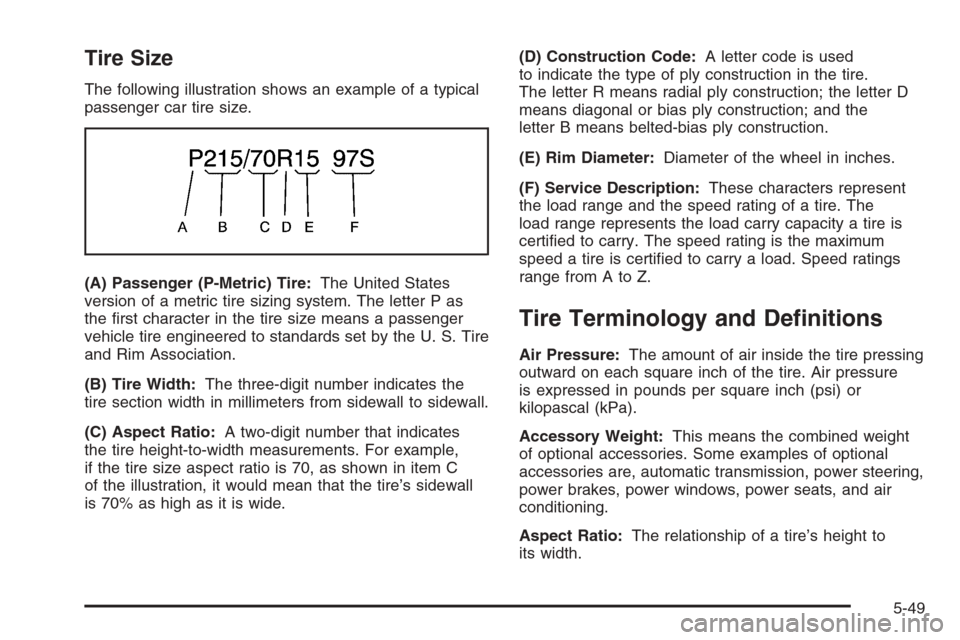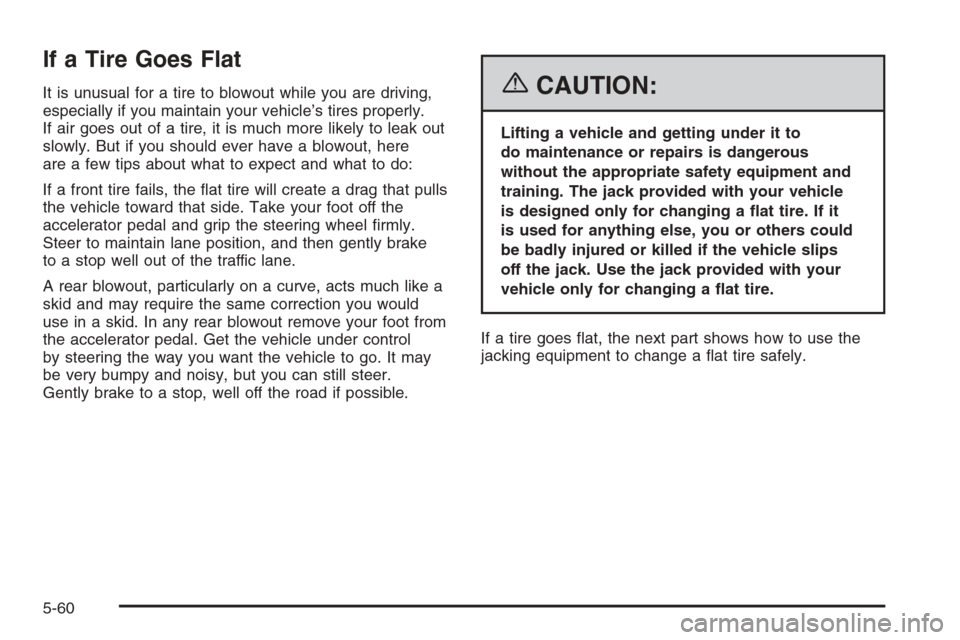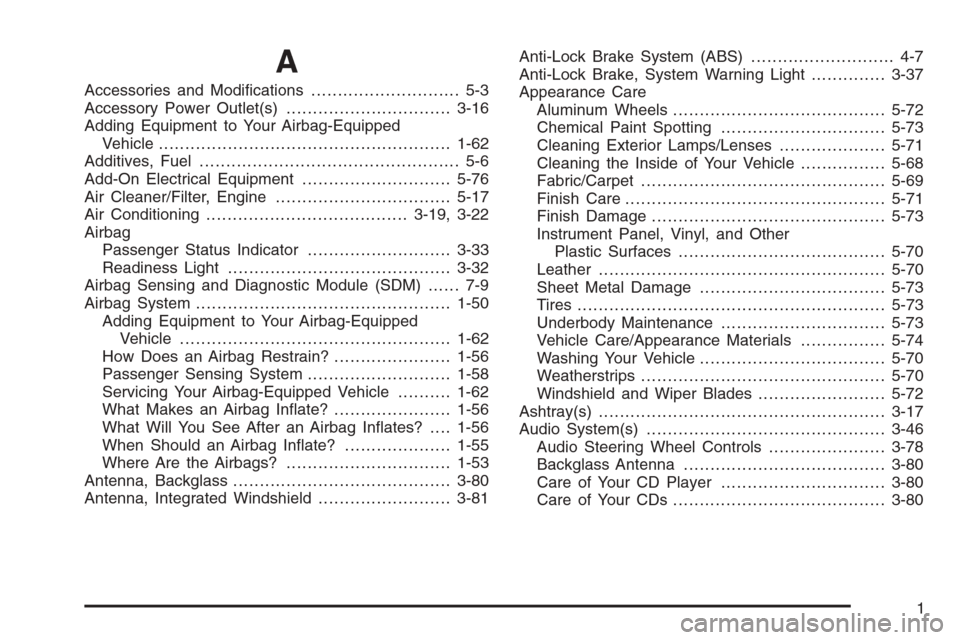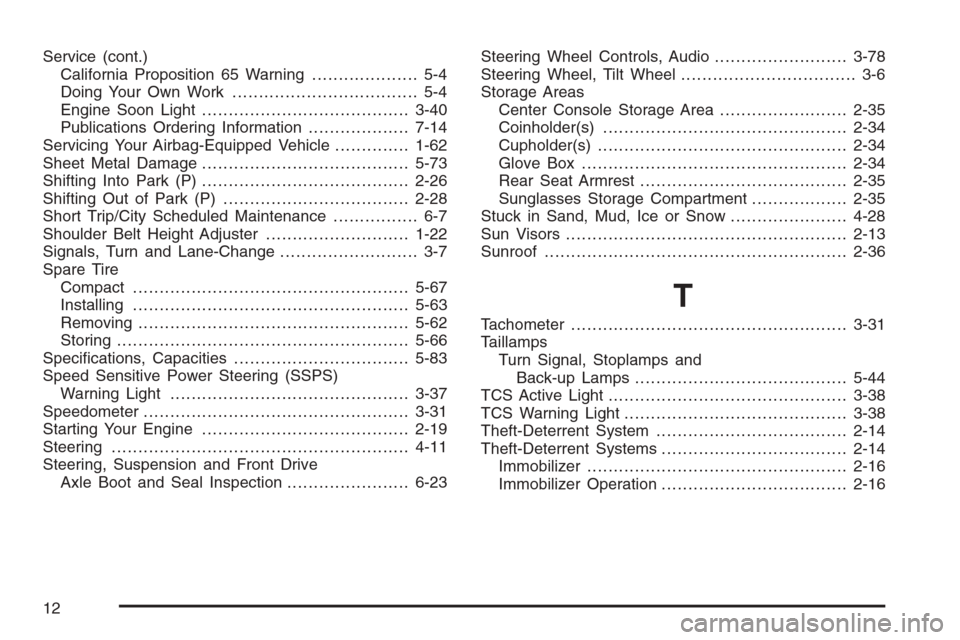2006 CHEVROLET EPICA steering wheel
[x] Cancel search: steering wheelPage 273 of 368

Tire Size
The following illustration shows an example of a typical
passenger car tire size.
(A) Passenger (P-Metric) Tire:The United States
version of a metric tire sizing system. The letter P as
the first character in the tire size means a passenger
vehicle tire engineered to standards set by the U. S. Tire
and Rim Association.
(B) Tire Width:The three-digit number indicates the
tire section width in millimeters from sidewall to sidewall.
(C) Aspect Ratio:A two-digit number that indicates
the tire height-to-width measurements. For example,
if the tire size aspect ratio is 70, as shown in item C
of the illustration, it would mean that the tire’s sidewall
is 70% as high as it is wide.(D) Construction Code:A letter code is used
to indicate the type of ply construction in the tire.
The letter R means radial ply construction; the letter D
means diagonal or bias ply construction; and the
letter B means belted-bias ply construction.
(E) Rim Diameter:Diameter of the wheel in inches.
(F) Service Description:These characters represent
the load range and the speed rating of a tire. The
load range represents the load carry capacity a tire is
certified to carry. The speed rating is the maximum
speed a tire is certified to carry a load. Speed ratings
range from A to Z.
Tire Terminology and De�nitions
Air Pressure:The amount of air inside the tire pressing
outward on each square inch of the tire. Air pressure
is expressed in pounds per square inch (psi) or
kilopascal (kPa).
Accessory Weight:This means the combined weight
of optional accessories. Some examples of optional
accessories are, automatic transmission, power steering,
power brakes, power windows, power seats, and air
conditioning.
Aspect Ratio:The relationship of a tire’s height to
its width.
5-49
Page 284 of 368

If a Tire Goes Flat
It is unusual for a tire to blowout while you are driving,
especially if you maintain your vehicle’s tires properly.
If air goes out of a tire, it is much more likely to leak out
slowly. But if you should ever have a blowout, here
are a few tips about what to expect and what to do:
If a front tire fails, the flat tire will create a drag that pulls
the vehicle toward that side. Take your foot off the
accelerator pedal and grip the steering wheel firmly.
Steer to maintain lane position, and then gently brake
to a stop well out of the traffic lane.
A rear blowout, particularly on a curve, acts much like a
skid and may require the same correction you would
use in a skid. In any rear blowout remove your foot from
the accelerator pedal. Get the vehicle under control
by steering the way you want the vehicle to go. It may
be very bumpy and noisy, but you can still steer.
Gently brake to a stop, well off the road if possible.{CAUTION:
Lifting a vehicle and getting under it to
do maintenance or repairs is dangerous
without the appropriate safety equipment and
training. The jack provided with your vehicle
is designed only for changing a �at tire. If it
is used for anything else, you or others could
be badly injured or killed if the vehicle slips
off the jack. Use the jack provided with your
vehicle only for changing a �at tire.
If a tire goes flat, the next part shows how to use the
jacking equipment to change a flat tire safely.
5-60
Page 355 of 368

A
Accessories and Modifications............................ 5-3
Accessory Power Outlet(s)...............................3-16
Adding Equipment to Your Airbag-Equipped
Vehicle.......................................................1-62
Additives, Fuel................................................. 5-6
Add-On Electrical Equipment............................5-76
Air Cleaner/Filter, Engine.................................5-17
Air Conditioning......................................3-19, 3-22
Airbag
Passenger Status Indicator...........................3-33
Readiness Light..........................................3-32
Airbag Sensing and Diagnostic Module (SDM)...... 7-9
Airbag System................................................1-50
Adding Equipment to Your Airbag-Equipped
Vehicle...................................................1-62
How Does an Airbag Restrain?......................1-56
Passenger Sensing System...........................1-58
Servicing Your Airbag-Equipped Vehicle..........1-62
What Makes an Airbag Inflate?......................1-56
What Will You See After an Airbag Inflates?....1-56
When Should an Airbag Inflate?....................1-55
Where Are the Airbags?...............................1-53
Antenna, Backglass.........................................3-80
Antenna, Integrated Windshield.........................3-81Anti-Lock Brake System (ABS)........................... 4-7
Anti-Lock Brake, System Warning Light..............3-37
Appearance Care
Aluminum Wheels........................................5-72
Chemical Paint Spotting...............................5-73
Cleaning Exterior Lamps/Lenses....................5-71
Cleaning the Inside of Your Vehicle................5-68
Fabric/Carpet..............................................5-69
Finish Care.................................................5-71
Finish Damage............................................5-73
Instrument Panel, Vinyl, and Other
Plastic Surfaces.......................................5-70
Leather......................................................5-70
Sheet Metal Damage...................................5-73
Tires..........................................................5-73
Underbody Maintenance...............................5-73
Vehicle Care/Appearance Materials................5-74
Washing Your Vehicle...................................5-70
Weatherstrips..............................................5-70
Windshield and Wiper Blades........................5-72
Ashtray(s)......................................................3-17
Audio System(s).............................................3-46
Audio Steering Wheel Controls......................3-78
Backglass Antenna......................................3-80
Care of Your CD Player...............................3-80
Care of Your CDs ........................................3-80
1
Page 366 of 368

Service (cont.)
California Proposition 65 Warning.................... 5-4
Doing Your Own Work................................... 5-4
Engine Soon Light.......................................3-40
Publications Ordering Information...................7-14
Servicing Your Airbag-Equipped Vehicle..............1-62
Sheet Metal Damage.......................................5-73
Shifting Into Park (P).......................................2-26
Shifting Out of Park (P)...................................2-28
Short Trip/City Scheduled Maintenance................ 6-7
Shoulder Belt Height Adjuster...........................1-22
Signals, Turn and Lane-Change.......................... 3-7
Spare Tire
Compact....................................................5-67
Installing....................................................5-63
Removing...................................................5-62
Storing.......................................................5-66
Specifications, Capacities.................................5-83
Speed Sensitive Power Steering (SSPS)
Warning Light.............................................3-37
Speedometer..................................................3-31
Starting Your Engine.......................................2-19
Steering........................................................4-11
Steering, Suspension and Front Drive
Axle Boot and Seal Inspection.......................6-23Steering Wheel Controls, Audio.........................3-78
Steering Wheel, Tilt Wheel................................. 3-6
Storage Areas
Center Console Storage Area........................2-35
Coinholder(s)..............................................2-34
Cupholder(s)...............................................2-34
Glove Box..................................................2-34
Rear Seat Armrest.......................................2-35
Sunglasses Storage Compartment..................2-35
Stuck in Sand, Mud, Ice or Snow......................4-28
Sun Visors.....................................................2-13
Sunroof.........................................................2-36
T
Tachometer....................................................3-31
Taillamps
Turn Signal, Stoplamps and
Back-up Lamps........................................5-44
TCS Active Light.............................................3-38
TCS Warning Light..........................................3-38
Theft-Deterrent System....................................2-14
Theft-Deterrent Systems...................................2-14
Immobilizer.................................................2-16
Immobilizer Operation...................................2-16
12